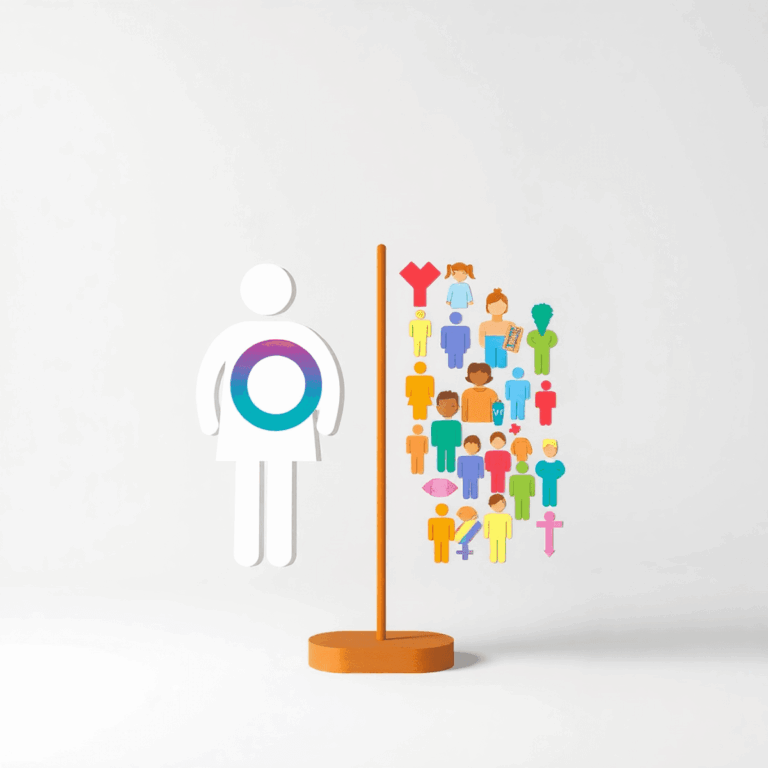
What is a sex addict?
Sex addiction is a term that often sparks curiosity, concern, and controversy. You may have heard discussions about it in quiet conversations or seen dramatic portrayals in movies and TV shows, but what does it really mean to be a sex addict?
A sex addict is someone who has an overwhelming and uncontrollable focus on sexual thoughts and behaviors that interfere with their daily life. This condition, also known as compulsive sexual behavior or hypersexuality, affects 3-10% of the population.
Imagine this: a person stuck in a cycle of intense sexual urges, unable to concentrate on work, maintain relationships, or find inner peace. Their sexual activities don’t bring them pleasure – instead, they lead to a downward spiral of:
- Shame and guilt
- Relationship problems
- Career struggles
- Financial difficulties
- Health risks
Understanding sex addiction goes beyond mere curiosity – it’s about acknowledging a genuine struggle that impacts millions of people. If you find yourself questioning your sexual behaviors or feeling powerless over your desires, recognizing the signs and symptoms can be your initial step towards healing.
For those who are navigating these turbulent waters, resources like Cheat River Review can offer valuable insights and support.
Defining Sex Addiction
Sex addiction is characterized by an uncontrollable pattern of sexual thoughts and behaviors that significantly disrupt daily life. Unlike healthy sexual expression, a sex addict experiences persistent, intrusive urges that create a cycle of compulsive sexual activity followed by shame and distress.
Key characteristics of sex addiction include:
- Intense cravings for sexual activities
- Inability to control or stop sexual behaviors
- Continued engagement despite negative consequences
- Progressive escalation of risky sexual activities
- Time-consuming preoccupation with sexual thoughts
Sex addiction shares similarities with substance addictions in terms of behavioral patterns and neurological responses. During sexual activities, the brain’s reward system releases dopamine, resulting in a biochemical “high” that reinforces addictive behavior. This physiological response can lead to:
- Tolerance development
- Withdrawal symptoms
- Compulsive pursuit of sexual stimulation
- Loss of control over sexual impulses
The typical onset of sex addiction occurs around age 18, although many individuals may not recognize their condition until years later. The delay in seeking help often arises from:
- Denial of the problem
- Shame and stigma
- Confusion about normal versus problematic sexual behavior
- Fear of judgment from others
A sex addict may engage in various forms of sexual behavior, such as:
- Excessive masturbation
- Compulsive use of pornography
- Frequent casual sexual encounters
- Cyber or phone sex
- Multiple affairs or relationships
The difference between healthy sexual behavior and addiction lies in the level of control, impact on daily functioning, and presence of emotional distress. When sexual thoughts and activities become the primary focus of life, interfering with work, relationships, and personal well-being, it indicates a potential addiction requiring professional intervention.
It’s crucial to understand the distinction between sex and gender, as these concepts have different implications when exploring the complexities surrounding sexual behavior and identity.
Moreover, it’s important to note that sex addiction can also manifest in other compulsive behaviors, similar to those seen in conditions like compulsive gambling. This further emphasizes the need for professional intervention and support to address these harmful patterns effectively.
Recognizing the Signs: Symptoms and Effects of Sex Addiction
Sex addiction shows up through specific emotional and behavioral patterns that greatly affect everyday life. Knowing these signs can help us understand when sexual behavior goes from being normal to becoming an addiction.
Emotional Indicators:
- Strong feelings of guilt and shame after sexual activities
- Deep loneliness and feeling emotionally isolated
- Ongoing worry about sexual urges
- Dislike for oneself and feeling less valuable
- Mood swings connected to cycles of sexual behavior
Behavioral Red Flags:
- Constantly thinking about sex in a way that disrupts work or daily activities
- Unable to stop or cut back on sexual activities even though attempts have been made
- Taking bigger risks to find satisfaction
- Using sex as a way to deal with stress or negative emotions
- Keeping sexual activities a secret from loved ones
Impact on Personal Life:
- Hurting close relationships and causing trust issues
- Financial difficulties caused by pursuing sexual activities
- Legal problems due to dangerous sexual behavior
- Setbacks in one’s career because of decreased productivity
- Physical health dangers from engaging in unsafe sexual practices
The effects of sex addiction spread into every part of life. You might find yourself missing important deadlines at work because you spent too much time watching pornography, or your partner might stumble upon multiple dating app accounts on your phone. These situations create a cycle of shame that pushes you further into addictive behavior.
Physical symptoms can include problems with sexual function, tiredness, and a higher risk of sexually transmitted infections. The psychological impact often leads to withdrawing from social situations, depression, and difficulty in maintaining meaningful relationships. These common sex addiction withdrawal symptoms further complicate the situation, making it even harder to break free from the cycle.
Moreover, the relationship between stress and physical health is well documented. Engaging in unsafe sexual practices as a way to cope with stress can lead to serious physical health dangers, creating a vicious cycle that’s difficult to escape from.
Understanding the Causes: Factors Behind Sex Addiction
Sex addiction is caused by a combination of psychological, biological, and social factors. Research has identified several key contributors that can trigger and sustain compulsive sexual behavior:
1. Psychological Trauma
- Childhood sexual abuse
- Physical or emotional neglect
- Attachment issues from unstable family relationships
- Exposure to inappropriate sexual content at a young age
2. Neurobiological Factors
- Imbalances in brain chemicals like dopamine and serotonin
- Genetic predisposition to addictive behaviors
- Changes in brain structure affecting impulse control
- Hormonal irregularities
3. Co-occurring Mental Health Conditions
- Bipolar disorder
- Depression and anxiety
- Attention Deficit Hyperactivity Disorder (ADHD)
- Obsessive-Compulsive Disorder (OCD)
4. Environmental Triggers
- High levels of stress
- Social isolation
- Easy access to sexual content
- Substance abuse and alcoholism
The development of sex addiction often involves multiple factors working together. For example, a person might experience childhood trauma, develop depression, and turn to sexual behavior as a way to cope. This creates a cycle where sexual activity temporarily relieves emotional pain but leads to increased shame and isolation.
Research shows that individuals with substance abuse problems are at a higher risk of developing sex addiction. The combination of substance use and compulsive sexual behavior can worsen both conditions, making treatment more complicated.
Understanding these underlying causes helps mental health professionals create targeted treatment approaches that address both the addiction and its root causes.
Seeking Help: Treatment Options for Managing Sex Addiction
Treatment for sex addiction involves a comprehensive approach tailored to each individual’s specific needs and circumstances. Professional help typically combines different therapeutic methods to address both behavioral patterns and underlying emotional issues.
Therapeutic Approaches
- Individual psychotherapy sessions focusing on identifying triggers and developing coping strategies
- Group therapy providing peer support and shared experiences
- Couples or family therapy to repair damaged relationships
- Trauma-focused therapy addressing past experiences
Cognitive Behavioral Therapy (CBT)
CBT stands as a primary treatment method for sex addiction. This structured approach helps you:
- Recognize destructive thought patterns
- Learn healthy sexual behaviors
- Develop stress management techniques
- Build relapse prevention skills
- Create accountability systems
Medication Options
While no specific medications treat sex addiction directly, certain prescriptions can help manage associated symptoms:
- Antidepressants (SSRIs) – reduce compulsive urges and regulate mood
- Mood stabilizers – help control impulsive behaviors
- Anti-androgen medications – decrease sexual urges in severe cases
Treatment Programs
Different levels of care exist based on severity:
- Outpatient therapy – weekly sessions while maintaining daily routines
- Intensive outpatient programs – multiple weekly sessions
- Residential treatment – full-time care in a controlled environment
Many treatment facilities offer specialized programs combining these approaches with additional support services like mindfulness training, art therapy, or physical exercise components. Your healthcare provider can help determine the most appropriate treatment plan based on your specific situation and needs.
Controversies in Understanding Sex Addiction as a Mental Disorder
The medical community remains divided on classifying sex addiction as a mental disorder. The Diagnostic and Statistical Manual of Mental Disorders (DSM-5) doesn’t recognize sex addiction as an official diagnosis, highlighting the complexity of this debate.
Key points of contention include:
- The challenge of distinguishing between normal sexual behavior and addiction
- Limited empirical research supporting sex addiction as a distinct disorder
- Concerns about potentially stigmatizing healthy sexual expression
- Questions about the validity of addiction model application to sexual behavior
Mental health professionals who oppose the classification argue that labeling sexual behavior as an addiction might pathologize natural variations in human sexuality. They point to cultural and religious influences that can shape perceptions of “normal” sexual behavior.
Supporters of the classification present evidence of similar neural pathways between sex addiction and substance dependencies. They highlight patterns of escalation, withdrawal symptoms, and inability to control behavior despite negative consequences.
The World Health Organization has taken a middle ground by including “Compulsive Sexual Behavior Disorder” in the ICD-11, classifying it as an impulse control disorder rather than an addiction. This classification acknowledges the reality of problematic sexual behavior while avoiding the controversial addiction framework.
Research continues to explore biological markers, brain imaging studies, and behavioral patterns to better understand and classify compulsive sexual behavior.
Finding Support: Self-Help Groups for Individuals Struggling with Compulsive Sexual Behavior
Self-help groups are a crucial support system for individuals dealing with compulsive sexual behavior. These groups provide safe and non-judgmental environments where members can openly discuss their experiences, difficulties, and successes with others who understand their struggles.
Popular self-help organizations include:
- Sex Addicts Anonymous (SAA): Follows a 12-step program adapted from Alcoholics Anonymous
- Sexual Compulsives Anonymous (SCA): Focuses on developing healthy sexuality and relationships
- Sexaholics Anonymous (SA): Emphasizes complete sexual sobriety from problematic behaviors
- Sex and Love Addicts Anonymous (SLAA): Addresses both sexual and romantic compulsions
These groups offer several key advantages:
- Peer Support: Regular meetings with others facing similar challenges
- Accountability: Sponsor relationships and check-ins help maintain recovery
- Resources: Access to educational materials and recovery tools
- Anonymous Setting: Privacy protection for members
- Cost-Free: Most groups operate on voluntary donations
Many self-help groups now offer both in-person and online meetings, making support accessible regardless of location or schedule constraints. Virtual meetings can be particularly helpful for individuals who feel uncomfortable attending face-to-face sessions or live in areas with limited local resources.
Groups often incorporate structured programs, reading materials, and workbooks to help members track their progress and maintain their recovery journey. Some organizations also offer separate meetings for partners and family members affected by a loved one’s compulsive sexual behavior.
Conclusion
Living with uncontrollable sexual urges creates significant personal distress and can leave you feeling trapped in a cycle of destructive behaviors. If you’ve recognized signs of sex addiction in yourself while reading this article, know that you’re not alone – and help is available.
Professional support can provide you with:
- Effective coping strategies
- Tools to manage triggers
- Guidance for rebuilding relationships
- A safe space to process underlying trauma
Your journey to recovery starts with reaching out. Mental health professionals specializing in sexual compulsivity can help you develop a personalized treatment plan. They understand the complex nature of sex addiction and offer judgment-free support.
Don’t let shame or stigma prevent you from seeking the help you deserve. Taking that first step – whether it’s calling a therapist, joining a support group, or confiding in a trusted healthcare provider – can open the door to healing and recovery.
FAQs (Frequently Asked Questions)
What is a sex addict and how is it different from normal sexual behavior?
A sex addict is an individual who experiences overwhelming cravings for sex, leading to compulsive sexual behavior and a loss of control. Unlike normal sexual behavior, sex addiction involves persistent urges that cause personal distress and interfere with daily life.
What are the common signs and symptoms of sex addiction?
Common signs include obsessive sexual thoughts, feelings of guilt and shame, and engaging in risky or excessive sexual activities. These behaviors often negatively impact personal relationships and overall well-being.
What factors contribute to the development of sex addiction?
Sex addiction can be influenced by various factors such as past trauma, substance abuse, and co-occurring mental health disorders. Understanding these underlying causes is essential for effective treatment.
What treatment options are available for managing sex addiction?
Treatment typically involves therapy approaches like cognitive behavioral therapy (CBT) which helps address compulsive behaviors. In some cases, medications may be prescribed to manage symptoms associated with hypersexuality.
Is there controversy about classifying sex addiction as a mental disorder?
Yes, there is an ongoing debate within the medical community regarding whether sex addiction should be officially classified as a mental disorder. This discussion affects diagnosis, treatment approaches, and insurance coverage.
How can self-help groups support individuals struggling with compulsive sexual behavior?
Self-help groups provide peer support, guidance, and a safe space for individuals dealing with sex addiction. They play a crucial role in recovery by fostering accountability and shared experiences among members.


